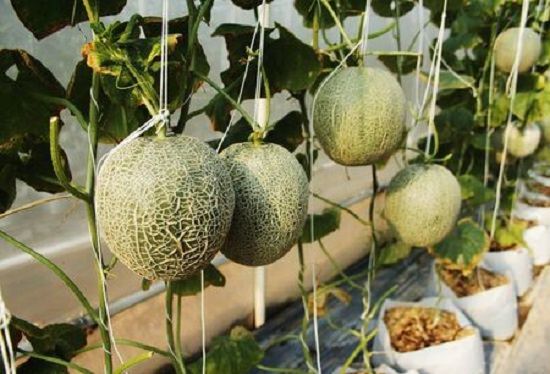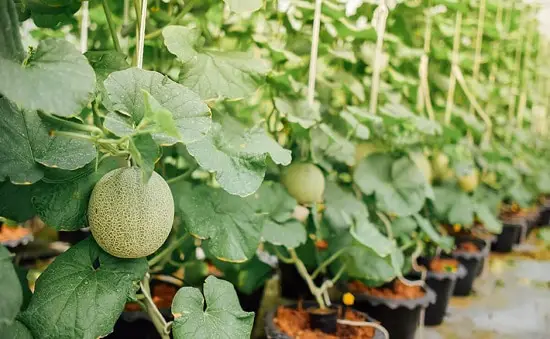If you’re short of space learn How to Grow Cantaloupes Vertically to enjoy them fresh and juicy in a limited space with or without garden.

If you have limited space and looking forward to growing cantaloupes, then planting them on a trellis or cage is a good option as it can work in a tight space as well. Read on the below article to learn how to grow cantaloupes vertically!
Check out our article on growing cucumbers vertically here!
Muskmelon Vs. Cantaloupes
All cantaloupes are muskmelons but not all muskmelons are cantaloupes. Mainly two varieties of muskmelon are cantaloupes – Cucumis melo reticulatus, having a reticulated skin that has a net-like appearance, and Cucumis melo cantalupensis, having light green, ribbed skin. This article is about all the varieties of muskmelons that you can grow vertically.
Why Should You Grow Cantaloupes Vertically
While growing cantaloupes, the first thing that comes to mind is space. If you are going to plant them horizontally, they will end up sprawling around 10-20 feet. Growing cantaloupes vertically helps gardeners to enjoy this juicy fruit in little space!
Also, while growing vertically, they do not acquire much space and offer a good harvest. It also keeps the foliage dry, making it less susceptible to diseases.
Want to grow climbing vegetables too? Check them out here!
How to Grow Cantaloupes Vertically
Trellis Size
While growing cantaloupes vertically, always go for a strong and sturdy trellis as you are growing a dense vine that will bear heavy fruits. Hence, there must be tough support to hold their weight. A trellis that is at least 6-8 feet tall and 15-20 feet wide is going to do the trick.
Some of the best options are hog fencing, livestock panels, and welded wires. Also, find something that creates a support system for the vines to climb upon. After you construct the vertical support, make sure it is tied or wired together well. You can also use cages! Check out these DIY Cage Ideas here.
When the vines are going to get mature, they’ll end up interweaving together around the support. To make sure that the fruits get proper backing and don’t fall, you can make slings below them, using scrap cloths or nylons strings. Make the slings tight below the fruits but leave enough room for the vines to grow freely.
To get more ideas on how to make a trellis, click here!
Propagating and Planting Cantaloupes

The best way is to sow the seeds directly in the containers or desired location. Plant them in spring or early summer, when the weather warms up sufficiently, 2-4 weeks after the expected last frost date. Sow seeds about an inch deep, cover them with soil and water well. Do make sure not to place more than 2 seeds in one pot. They will germinate 7-14 days.
- If you’re living in a warm and frost-free climate, start sowing seeds in winter or spring.
- The temperature around or above 60-65 F (15-18 C) is favorable for seed germination.
- Most of these melon varieties need 70-110 warm frost-free days to grow and fruit well.
- You can also start the seeds indoors in biodegradable pots.
Pot Size for Planting Cantaloupes
For growing cantaloupes, you’ll need a large 16 to 18 inches pot. In a really large, 24 inches pot, you can try growing 2 cantaloupes vines. You can also make a trellis or cage around the pot, at the time of planting so they get the right support system from the start.
Cantaloupes Varieties
To know everything in detail about the available cantaloupes varieties, you can check out the list on Purdue University Website!
Requirements for Growing Cantaloupes Vertically
Position
When selecting a position for your cantaloupe plants, do remember this is a warm-season crop that needs good drainage and plenty of sunlight with a temperature range of 65-90 F (18-32 C) to grow well.
Soil
They grow best in well-draining soil that is very loamy and rich in organic matter with a pH of 6-7. You can mix aged manure or compost to enrich the soil.
Watering

All melons need regular watering and evenly moist soil. The cantaloupes are no different! You’ll need to water the plants thoroughly until it starts to drain freely from the bottom, keeping the soil moist all the time but not overly saturated. Also, avoid wetting the foliage.
Mulching
Mulching is important, especially when growing on the ground. Mulch around the base of the plant to boost the moisture-retaining ability as well as for keeping the soil warm.
Pruning
To keep the plant healthy and productive, remove the side branches. This is going to allow the main vine to grow effectively. Also, timely remove the damaged and diseased stems.
Fertilizer
You can start fertilizing the plant using a complete liquid fertilizer. When flowers start to appear on the plant, use a fertilizer with less nitrogen. To make the fruits sweeter, mix 6-7 tablespoons of Epsom salt and 3-4 tablespoons of household borax in 5 gallons of water. Stir well and spray this solution on the vines.
Diseases and Pests
Cantaloupe plants particularly suffer from charcoal rot, anthracnose, fungal infections, and powdery mildew. Common garden pests like aphids, pickle worms, cucumber beetles, and spider mites can be taken care of with the use of insecticides.
Harvesting

When you are going to notice the color of the fruits changing from green to tan or yellow-gray, it is time to harvest the Cantaloupe. They also start to smell sweet at this point. Carefully cut the melon from the vine, making sure that you are not damaging the plant in the process.
Some Helpful Tips
- As Cantaloupes need a lot of water, do ensure that you are keeping the soil moist. Avoid wetting the foliage while watering the plants.
- Keep the young fruits off the ground to save them from rotting. You can use old pots and lie them upside down to rest the fruits.
- Healthy leaves are going to produce sweeter fruits; avoid pinching the shoots.
- If you want the best flavor, keep the biggest fruits on the vine and pinch off the young ones.




Great info!
The good news is that with a pinch of creativity and a dash of careful setup, anyone can train cantaloupe to grow vertically on a trellis of nearly any type.
I planted a hami melon in a pot at my balcony. Its climbing upwards n now about 6 feet tall. I am going to run out of space (height). Any advice on how to reduce its upward growth. Thank you for your assistance.
When the fruits start then you should pinch back the vines so the energy goes to the developing fruit and once it is into the season take off the new fruit they won’t have time to grow and take the energy from the developing melons I also used a folding rubber coated metal book shelf and went all around it with vines and let the melons rest on the shelves for support . It sounds hokey but it works I usually get about 6-7 melons on a vine so it’s enough. And I stop using fertilizer to promote vine growth when the fruit starts I switch to fish meal
I once got my head stuck in a drawer I hope this helps